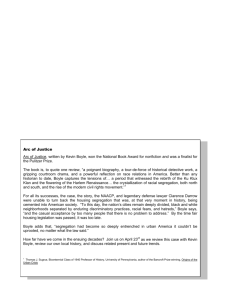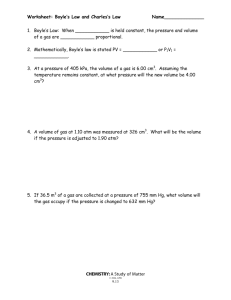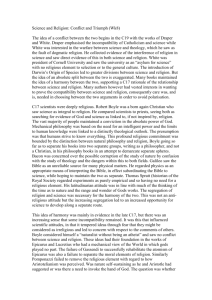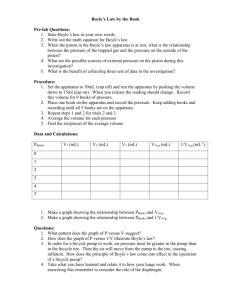Boyle's Law - Nuffield Foundation
advertisement
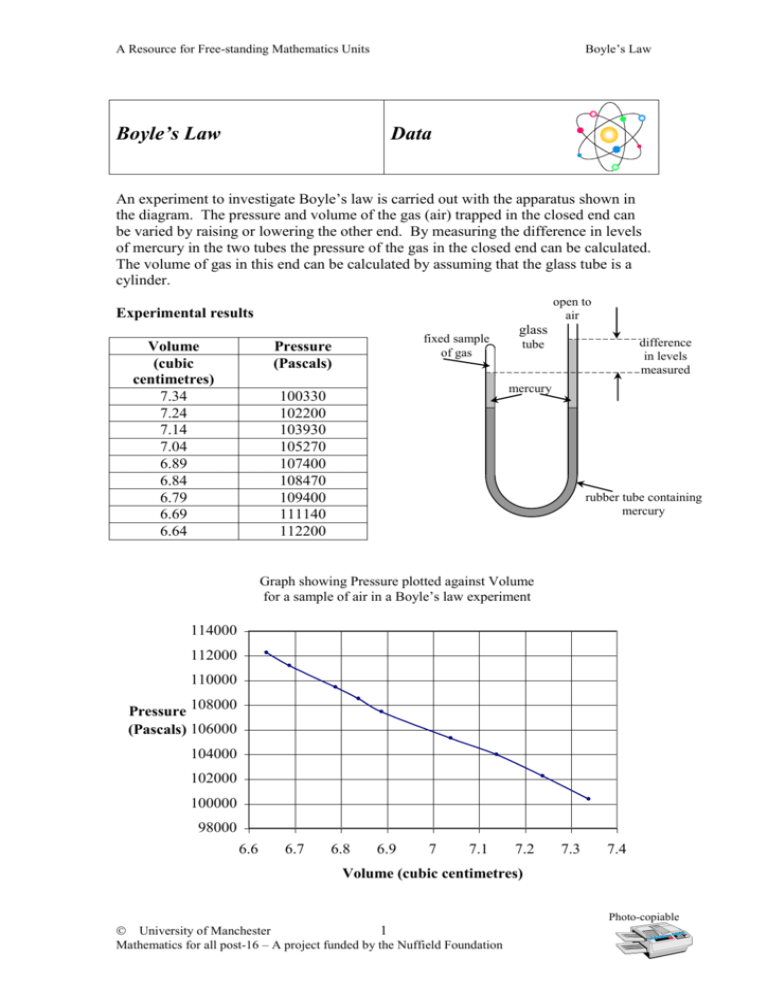
Boyle’s Law A Resource for Free-standing Mathematics Units Boyle’s Law Data An experiment to investigate Boyle’s law is carried out with the apparatus shown in the diagram. The pressure and volume of the gas (air) trapped in the closed end can be varied by raising or lowering the other end. By measuring the difference in levels of mercury in the two tubes the pressure of the gas in the closed end can be calculated. The volume of gas in this end can be calculated by assuming that the glass tube is a cylinder. open to air Experimental results Volume (cubic centimetres) 7.34 7.24 7.14 7.04 6.89 6.84 6.79 6.69 6.64 fixed sample of gas Pressure (Pascals) glass difference in levels measured tube mercury 100330 102200 103930 105270 107400 108470 109400 111140 112200 rubber tube containing mercury Graph showing Pressure plotted against Volume for a sample of air in a Boyle’s law experiment 114000 112000 110000 Pressure 108000 (Pascals) 106000 104000 102000 100000 98000 6.6 6.7 6.8 6.9 7 7.1 7.2 7.3 7.4 Volume (cubic centimetres) Photo-copiable University of Manchester 1 Mathematics for all post-16 – A project funded by the Nuffield Foundation Boyle’s Law A Resource for Free-standing Mathematics Units Boyle’s Law Discussion Can we use a linear function to model the experimental data? What do science books tell us about Boyle’s Law? Does our data fit this law? Graph showing Pressure plotted against Volume for a sample of air in a Boyle’s law experiment 114000 Can we find a function to fit our data? 112000 110000 Pressure 108000 (Pascals) 106000 104000 102000 100000 98000 6.6 6.7 6.8 6.9 7 7.1 7.2 7.3 7.4 Volume (cubic centimetres) What would happen where the pressure was very small? What would happen where the volume was very small? Is this realistic? What does the gradient of the graph tell us? Photo-copiable University of Manchester 2 Mathematics for all post-16 – A project funded by the Nuffield Foundation Boyle’s Law A Resource for Free-standing Mathematics Units Boyle’s Law Sample assessment question Throughout this question refer to the Boyle’s Law Data. Boyle’s Law states that the pressure of a fixed sample of gas is inversely 1 k proportional to its volume. That is, P , and therefore P . V V Indicate which of the graphs below could be of a gas that obeys Boyle’s Law. a (i) A B P P V V C V D P P V V (ii) Explain your choice of graph by explaining what happens to the pressure of the gas when the volume is very small and very large. (iii) The gas used in the experiment of the data sheet is taken to obey Boyle’s Law, k P . V Calculate the value of k if it is assumed that the law is true when the volume of the gas is 7.04 cubic centimetres. (iv) Use the value of k you found in part (iii) in Boyle’s law to find the volume of gas when its pressure is 100000 Pascals. Photo-copiable University of Manchester 3 Mathematics for all post-16 – A project funded by the Nuffield Foundation Boyle’s Law A Resource for Free-standing Mathematics Units b The graph below shows the first four data points plotted and a straight line that may be used to model this. Pressure (Pascals) Graph showing Pressure plotted against Volume for a sample of air 106000 105000 104000 103000 Data Linear model 102000 101000 100000 7 7.05 7.1 7.15 7.2 7.25 7.3 7.35 7.4 Volume (cm3) (i) The straight line has the same gradient as another straight line joining the points (7.34, 100330) and (7.14, 103930). Find the gradient of the line stating clearly its units. (ii) The straight line passes through the point (7.24, 102200). find the equation of the line in the form P aV b where a and b are constants that you find. (iii) Explain why this linear model would not be suitable for a wide range of gas pressures by referring to what it predicts at very large and small volumes. Photo-copiable University of Manchester 4 Mathematics for all post-16 – A project funded by the Nuffield Foundation Boyle’s Law A Resource for Free-standing Mathematics Units Boyle’s Law Assignment Refer to the Boyle’s Law Data. Check calculations. 1. Draw an accurate graph showing the given data. 2. Draw the line of best fit (linear). 3. Calculate the gradient of the line and explain what information it gives. 4. Determine the equation of the line. 5. Use a graphic calculator or computer to check the equation of your line of best fit. 6. Why is the linear model not a good model in this case? 7. Consider the following models: P = kV2 + c P = aV3 P= k V Which of these equations could also be used to model the data? Explain your answer carefully, using sketches of the suggested models. 8. Assuming that your chosen model is correct, estimate the value of k using the experimental value for the pressure when the volume of the gas is 7.04 cubic centimetres. 9. Use the model you have chosen and your estimate of k to a) predict the pressure for various values of the volume (to be chosen by you) b) draw a graph for volumes between 6.6 cm3 and 7.4 cm3 (by hand or using a computer) Comment on your results. Photo-copiable University of Manchester 5 Mathematics for all post-16 – A project funded by the Nuffield Foundation Boyle’s Law A Resource for Free-standing Mathematics Units Teacher Notes Boyle’s Law Which Free-standing unit does this material support? Intermediate Level – Using algebra, functions and graphs Coursework Portfolio The assignment can be used to give practice in the methods needed to produce evidence for sections a and b. What students need to know How to plot graphs by hand and on graphic calculators or computers How to find the equation of the linear line of best fit The shapes of graphs of equations of the form y kx2 c , y kx3 and y k x General Notes The Boyle’s Law package includes a data sheet giving experimental data and a discussion sheet, sample examination question and assignment based on this data. Ideally data used in students’ portfolios should be identified and collected by the students themselves, but the assignment in this package can be used to give practice. Answers to Sample Assessment Question a (i) (ii) B When the volume is very small, the pressure is very high. When the volume is very large, the pressure is very low. 741 100 (to 4 sf) 7.411 cm3 (4 sf) (iii) (iv) b – 18 000 Pascals cm-3 P = - 18 000V + 232 520 Very large volume would give a negative pressure Would predict a pressure of 235 520 Pascals for zero volume. (i) (ii) (iii) Answers to Assignment 3. Gradient approximately – 16 000 Pascals per cm3 gives reduction in pressure per unit increase in volume. 5. P = - 16 250V + 219 700 (to 4 sf) from graphic calculator 6. Predicts unrealistic pressure for large and small volume. 7. P 8. 741 100 (4 sf) k V Photo-copiable University of Manchester 6 Mathematics for all post-16 – A project funded by the Nuffield Foundation

